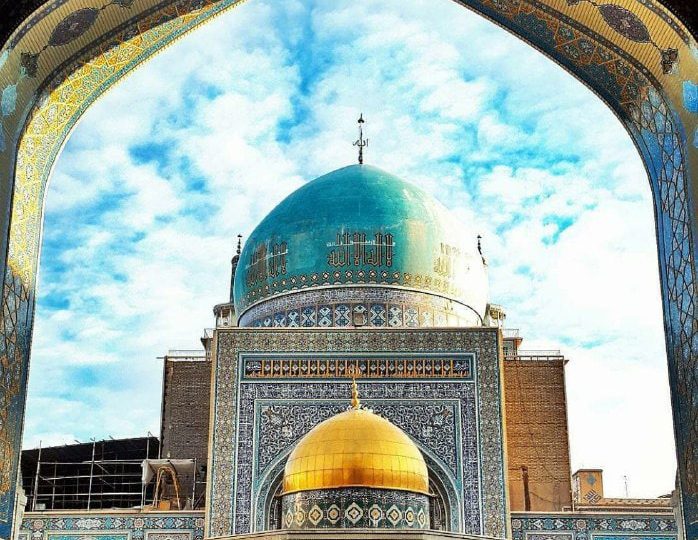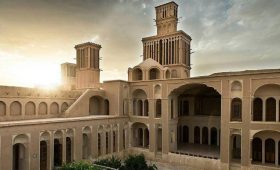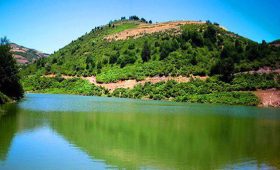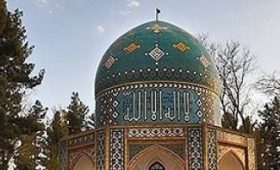Goharshad Mosque is one of the original mosques in the history of Iranian-Islamic architecture and is considered one of the must-see places in Mashhad. This beautiful historical work shows the height of Iranian-Islamic art in the Timurid period. The art and architecture of the Timurid school are reflected in this work. This mosque can be very attractive and eye-catching for tourists in terms of architectural art. Stay with us in this article to learn more about Goharshad Mosque.
Goharshad Mosque is located in the south of Motahar Razavi Shrine and is one of the main places to be visited on a trip to Mashhad. This mosque is bounded from the north by the portico of Dar al-Siadeh and Dar al-Hafaz, from the south by the Quds courtyard, from the east by the portico under construction by Imam Khomeini, and from the west by Sheikh Baha’i.
Goharshad Mosque, that is one of the mosques with four porches, has a beautiful architecture and the total area of the mosque is about 9410 square meters. This mosque is the largest mosque in the Astan Quds Razavi complex, and its court area is 2,850 square meters. This court is considered to be the oldest court in terms of age, and it was built in the south of the holy shrine of Imam Reza (AS).
Goharshad Mosque was built by the order of Goharshad Aghar, the daughter of Amir Ghiyathuddin, the wife of Shahrukh Timuri and during the governorship of her son Baisenqormirza, in the year 794 on the south side of Imam Reza’s shrine in Mashhad. Mrs. Goharshad was one of the famous women of the Timurid era, who was highly regarded by the Emir of that time and consulted on state affairs. His name is written in two places of the mosque building, one above the entrance door of the Darlesiyadeh porch and the other in the inscription of the Maqsoureh porch with the beautiful calligraphy of Prince Baisanqar Mirza with mosaic tile as the founder of the mosque and has been remembered.
The architect of Goharshad Mosque was Qavamuddin bin Zainuddin Shirazi, a famous architect of the Timurid era. The architecture of the mosque is derived from the Islamic-Iranian style, and bricks and plaster are used in its construction. Goharshad Mosque has a courtyard, four porches and a turquoise dome, two beautiful garlands and seven naves, and due to its historical antiquity, architectural style and artistic beauty, it is one of the most important historical works of Mashhad and the architectural industry of Islamic Iran, which attracts many pilgrims. .
Goharshad Mosque is one of the historical-cultural and religious attractions and sightseeing places of Razavi Khorasan province, which is very popular among tourists and experts in architecture, history and art. Although six hundred years have passed since the construction of the mosque; But the strength and permanence of the mosque shows its greatness and antiquity. The mosque was damaged many times in different historical periods when Mashhad was involved in war, such as the Uzbek attack; but it was repaired by Shah Abbas Safavi. In later periods, the mosque was damaged due to an earthquake in Mashhad, which was restored during the Qajar period and its damages were repaired. This mosque is considered an excellent example in terms of building and tiling. All the doors and walls of the mosque are decorated with the names of the Most High, Quranic verses, hadiths and poetry and the praises of the pure imams, and they have been restored with the calligraphy of Thuluth, Nastaliq, Kufi and the construction of great calligraphers such as Baisanqar and Imami Isfahani.
Goharshad Mosque has a tall spire which is located in the middle of the four sides of the mosque complex, and the largest of them is called Ivan Moqsoura, located on the south side of the courtyard. The porch is 35 meters long with different widths. At the end of the porch, a beautiful altar can be seen, and the border around it is decorated with an inscription restored with mosaic tiles to Ayat al-Kursi, and the inner bases of the porch are decorated with white marble stones. On the right side of the altar, there is the Sahib al-Zaman pulpit, which is an old pulpit and was built in 1243 AH. The inlaid pulpit is made of pear and walnut wood without metal nails and was restored in 1320.
The north porch faces the qiblah in the same way as the porch of Maqsoora. This porch is connected to Dar al-Siadeh portico. On the front of the porch, there is an engraved inscription with a text written in a beautiful script about the restoration of the reign of Shah Abbas Safavid.
The third porch is the eastern porch of the mosque, which was known as Haj Hassan’s porch in the past. This porch is connected to Imam Khomeini’s portico. Inside the porch and on the north and south sides, there are three arches in the upper part, and in the inscription on the front of the porch, on both sides of the base of the porch and the front of the altar, and on the marble ceiling, there are inscriptions in Kufi Maaqli script on tiles.
The fourth porch is the west porch, which was connected to the market in the past, and now it is connected to the Sheikh Bahauddin Ameli mosque by a large door located in the middle of the porch, known as the stone door. In the past, the name of this porch was “Water Porch” and the channel for the passage of water into the mosque was under the porch. Inside this porch, three arches have been built facing the qibla (similar to the eastern porch) and in the front of the porch, in the ceiling, and in the middle of the pillars of the porch, surahs from the Holy Quran are engraved. The picture below is a part of the porch.
All the naves of the mosque are built around the porches. These naves are decorated with thick foundations and a hammered roof in the style of the traditional architecture of Iranian mosques and have been restored many times. But they still retain the old style. These seven naves have been called by different names in different eras.
Garm Shabestan: This Shabestan is located on the eastern side of the mosque between the eastern porch and the northern side of the mosque, and the northern edge of this Shabestan is the connecting path between the mosque and the portico connected to the Azadi courtyard. This chapel is a place of worship for men.
Shabestan Tabrizi: It is located on the south side, between the porch of Maqsura and the portico of Imam Khomeini. One of the names of this Shabestan in the past was Big Shabestan due to its size.
Shabestan Nahavandi: It is a large Shabestan that is located on the south side of the mosque and between the porch of the mosque and the bast of Sheikh Bahauddin Ameli and the Holy of Holies.
Sabzevari Shabestan: There is a small Shabestan in the south of the eastern porch. This nave is bounded from the east to the portico of Imam Khomeini, from the north with a corridor to the east porch, and from the west to the courtyard of the mosque.
Shabestan Milani: It is located on the west side of the mosque, between the west porch and the corridor connected to the Bast of Sheikh Bahauddin.
Shabestan Najafabadi: used to be known as Imam Juma’s Shabestan, on the west side of the mosque.
Shabestan Alavi or Aftab: It is located on the north side between the corridor of the northern part and Dar al-Siadeh portico and Parizad school. Except Garm Shabestan, which is a place of worship for men, other Shabestans are, by necessity, the place of Quran meetings, mourning ceremonies and celebrations, etc. The porch of Maqsoura and the porch connected to Dar al-Siadeh and the courtyard of the mosque are the place for performing congregational prayers, speeches and ceremonies.
The Goharshad mosque complex is now connected to other parts of the Razavi shrine with eight small and large entrances, three entrances on the west side of the mosque are connected to Sheikh Bahauddin, three entrances on the north side of the mosque are to the shrine, and two entrances on the south side of the mosque are to the courtyard. Quds connects.
With Reza Shah’s trip to Turkey, his efforts to change the religious foundations and oriental and traditional ways of the Iranian people intensified. The government issued an order to change the clothes and use the Shapo hat, which greatly affected the scholars and authorities. Ayatollah Haj Agha Hossein Qomi and Ayatollah Seyed Yunus Ardabili came to the conclusion during several meetings that changing clothes will lead to removing the hijab. Ayatollah Qomi decided to go to Tehran and negotiate with Reza Khan. Upon his arrival in the city of Ray, the police surrounded the residence. With the publication of the news of Ayatollah Qomi’s arrest, people’s feelings were hurt in Mashhad and a huge gathering was formed in Goharshad Mosque with the presence of Mashhad’s elders. There, Sheikh Muhammad Taqi Bahloul went to the pulpit and invited the people to resistance. After a few days, finally on the morning of Friday 20th of July 1314, the military forces surrounded the mosque and on the 21st of July, people’s resistance in Goharshad Mosque led to violence and killing.
.




